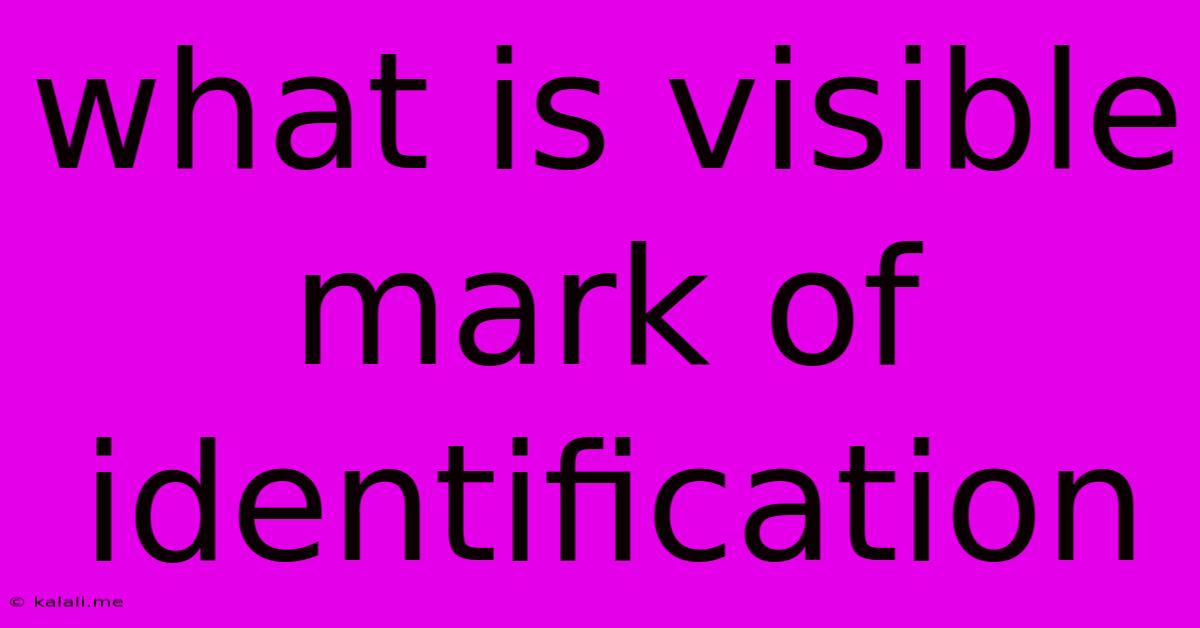What Is Visible Mark Of Identification
Kalali
Jun 13, 2025 · 3 min read

Table of Contents
What is a Visible Mark of Identification? A Comprehensive Guide
Visible marks of identification (VMIs) are any distinguishing features readily apparent to the naked eye that can be used to identify an individual. This is a crucial concept in various fields, from law enforcement to personal safety and even zoology. Understanding what constitutes a VMI and their implications is essential. This article will explore the definition, examples, applications, and ethical considerations surrounding visible marks of identification.
Defining Visible Marks of Identification
A VMI is essentially any physical characteristic that uniquely identifies a person. Unlike less obvious identifiers like DNA or fingerprints, VMIs are readily observable. They can be either natural or acquired. The key characteristic is their visibility – they don't require specialized equipment or procedures to be observed.
This broad definition encompasses a wide range of features, leading to important considerations regarding privacy and potential misuse.
Examples of Visible Marks of Identification
The range of possible VMIs is surprisingly broad, including:
-
Natural Features: Birthmarks (moles, hemangiomas), scars (congenital), unique facial features (eye shape, nose shape, etc.), unusual hair color or texture. These are characteristics present from birth or appearing naturally during development.
-
Acquired Features: Scars (from accidents, surgeries, or other injuries), tattoos, piercings, amputations. These are features that develop over time due to external factors or deliberate modifications.
It's important to note that the "uniqueness" of a VMI is relative. While some marks, such as a large, distinctive birthmark, are highly unusual, others, like a small scar, might be less so. The significance of a VMI often depends on the context.
Applications of Visible Marks of Identification
VMIs play significant roles in various contexts:
-
Law Enforcement: VMIs are used in witness descriptions, identifying suspects, and matching individuals to photographic evidence. They are vital in missing person cases and identifying victims of accidents or disasters.
-
Medical Identification: In cases of unconsciousness or amnesia, VMIs can help medical personnel identify patients. This is crucial in providing appropriate medical care and contacting family members.
-
Security and Access Control: Some security systems, particularly those for high-security areas, might use VMIs (along with other methods) for authentication purposes. Facial recognition technology relies heavily on unique visible features.
-
Personal Safety: Knowing your own distinguishing VMIs can be beneficial in emergency situations. This information can aid rescuers in identifying you.
Ethical Considerations
The use of VMIs raises several important ethical considerations, particularly surrounding privacy and potential biases:
-
Privacy concerns: The widespread collection and use of VMIs, especially through technology like facial recognition, raise significant privacy issues. The potential for misuse and surveillance is a major concern.
-
Bias and discrimination: The reliance on VMIs for identification can inadvertently perpetuate existing biases, particularly in law enforcement and security applications. Certain VMIs might be disproportionately associated with specific demographics, leading to unfair or discriminatory outcomes.
Conclusion: A Balancing Act
Visible marks of identification provide valuable tools for identification and security across various fields. However, responsible and ethical application is crucial to mitigate potential risks to privacy and fairness. A careful balance must be struck between leveraging the utility of VMIs and safeguarding individual rights and preventing discrimination. Clear regulations and guidelines are needed to ensure ethical and responsible usage.
Latest Posts
Latest Posts
-
Temple University Japan Campus Acceptance Rate
Jun 14, 2025
-
Which Of The Following Is Not An Aspect Of Globalization
Jun 14, 2025
-
Example Of Open Loop Control System
Jun 14, 2025
-
Which Of The Following Is A Weak Electrolyte
Jun 14, 2025
-
Which Of The Following Statements Are True Regarding Electric Generators
Jun 14, 2025
Related Post
Thank you for visiting our website which covers about What Is Visible Mark Of Identification . We hope the information provided has been useful to you. Feel free to contact us if you have any questions or need further assistance. See you next time and don't miss to bookmark.